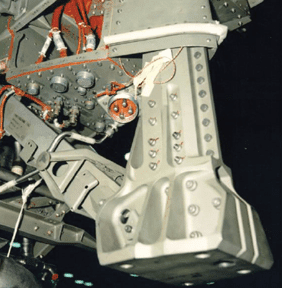Mounts for Reciprocating Engines
Most aircraft equipped with reciprocating engines use an engine mount structure made of welded steel tubing. The mount is constructed in one or more sections that incorporate the engine mount ring, bracing members (V-struts), and fittings for attaching the mount to the wing nacelle.
The engine mounts are usually secured to the aircraft by special heat-treated steel bolts. The importance of using only these special bolts can be readily appreciated, since they alone support the entire weight of, and withstand all, the stresses imposed by the engine and propeller in flight. The upper bolts support the weight of the engine while the aircraft is on the ground, but when the aircraft is airborne another stress is added. This stress is torsional and affects all bolts, not just the top bolts. A typical engine mount ring shown in Figure 1 discloses fittings and attachment points located at four positions on the engine mount structure. Each fitting houses a dynamic engine mount.
The section of an engine mount where the engine is attached is known as the engine mount ring. It is usually constructed of steel tubing having a larger diameter than the rest of the mount structure. It is circular in shape so that it can surround the engine, which is near the point of balance for the engine. The engine is usually attached to the mount by dynafocal mounts, attached to the engine at the point of balance forward of the mount ring. Other types of mounting devices are also used to secure the different engines to their mount rings.
As aircraft engines became larger and produced more power, some method was needed to absorb their vibration. This demand led to the development of the rubber and steel engine-suspension units called shock mounts. This combination permits restricted engine movement in all directions. These vibration isolators are commonly known as flexible, or elastic, shock mounts. An interesting feature common to most shock mounts is that the rubber and metal parts are arranged so that, under normal conditions, rubber alone supports the engine. Of course, if the engine is subjected to abnormal shocks or loads, the metal snubbers limit excessive movement of the engine. Dynafocal engine mounts, or vibration isolators, are units that give directional support to the engines. Dynafocal engine mounts have the mounting pad angled to point to the CG of the engines mass. [Figure 1]
Mounts for Turbofan Engines
The engine mounts on most turbofan engines perform the same basic functions of supporting the engine and transmitting the loads imposed by the engine to the aircraft structure. Most turbine engine mounts are made of stainless steel, and are typically located as illustrated in Figure 2. Some engine mounting systems use two mounts to support the forward end of the engine and a single mount at the rear end.
Turbine Vibration Isolation Engine Mounts
The vibration isolator engine mounts support the power plants and isolate the airplane structure from adverse engine vibrations. Each power plant is generally supported by forward vibration isolator mounts and an aft vibration isolator mount.
The forward vibration isolator engine mounts carry vertical, side, and axial (thrust) loads and allow engine growth due to thermal expansion. The aft mounts take only vertical and side loads; however, they will also accommodate thermal expansion of the engine without applying axial loads to the engine flanges.
The vibration isolators consist of a resilient material permanently enclosed in a metal case. As an engine vibrates, the resilient material deforms slightly, thereby dampening the vibrations before they reach the airplane structure. If complete failure or loss of the resilient material occurs, the isolators will continue to support the engine.


